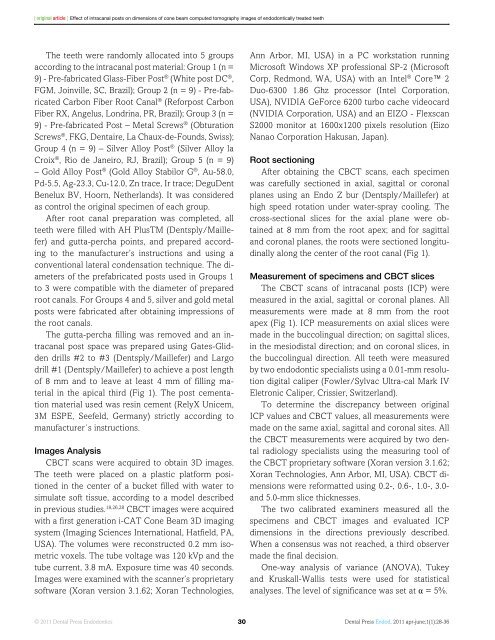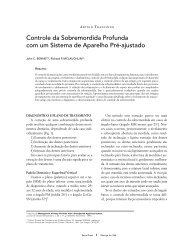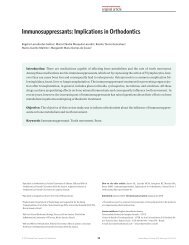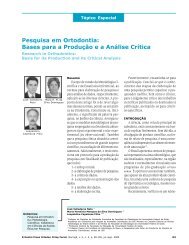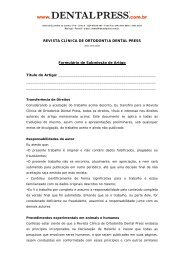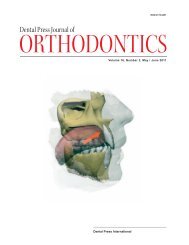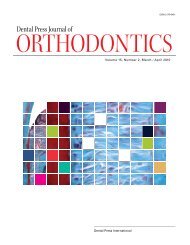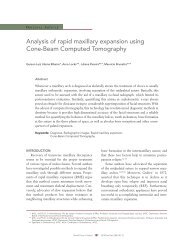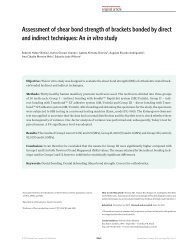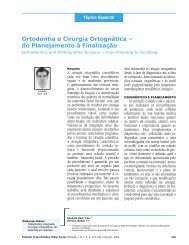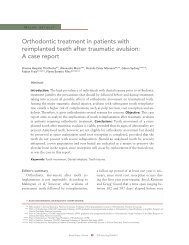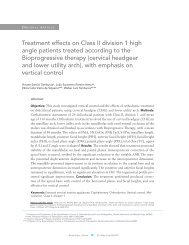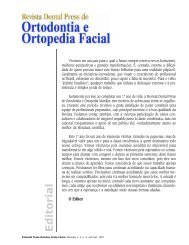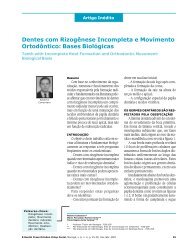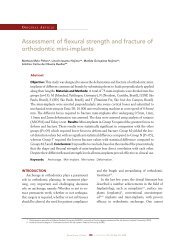Dental Press
Dental Press
Dental Press
You also want an ePaper? Increase the reach of your titles
YUMPU automatically turns print PDFs into web optimized ePapers that Google loves.
[ original article ] Effect of intracanal posts on dimensions of cone beam computed tomography images of endodontically treated teeth<br />
The teeth were randomly allocated into 5 groups<br />
according to the intracanal post material: Group 1 (n =<br />
9) - Pre-fabricated Glass-Fiber Post ® (White post DC ® ,<br />
FGM, Joinville, SC, Brazil); Group 2 (n = 9) - Pre-fabricated<br />
Carbon Fiber Root Canal ® (Reforpost Carbon<br />
Fiber RX, Angelus, Londrina, PR, Brazil); Group 3 (n =<br />
9) - Pre-fabricated Post – Metal Screws ® (Obturation<br />
Screws ® , FKG, Dentaire, La Chaux-de-Founds, Swiss);<br />
Group 4 (n = 9) – Silver Alloy Post ® (Silver Alloy la<br />
Croix ® , Rio de Janeiro, RJ, Brazil); Group 5 (n = 9)<br />
– Gold Alloy Post ® (Gold Alloy Stabilor G ® , Au-58.0,<br />
Pd-5.5, Ag-23.3, Cu-12.0, Zn trace, Ir trace; DeguDent<br />
Benelux BV, Hoorn, Netherlands). It was considered<br />
as control the original specimen of each group.<br />
After root canal preparation was completed, all<br />
teeth were filled with AH PlusTM (Dentsply/Maillefer)<br />
and gutta-percha points, and prepared according<br />
to the manufacturer’s instructions and using a<br />
conventional lateral condensation technique. The diameters<br />
of the prefabricated posts used in Groups 1<br />
to 3 were compatible with the diameter of prepared<br />
root canals. For Groups 4 and 5, silver and gold metal<br />
posts were fabricated after obtaining impressions of<br />
the root canals.<br />
The gutta-percha filling was removed and an intracanal<br />
post space was prepared using Gates-Glidden<br />
drills #2 to #3 (Dentsply/Maillefer) and Largo<br />
drill #1 (Dentsply/Maillefer) to achieve a post length<br />
of 8 mm and to leave at least 4 mm of filling material<br />
in the apical third (Fig 1). The post cementation<br />
material used was resin cement (RelyX Unicem,<br />
3M ESPE, Seefeld, Germany) strictly according to<br />
manufacturer´s instructions.<br />
Images Analysis<br />
CBCT scans were acquired to obtain 3D images.<br />
The teeth were placed on a plastic platform positioned<br />
in the center of a bucket filled with water to<br />
simulate soft tissue, according to a model described<br />
in previous studies. 18,26,28 CBCT images were acquired<br />
with a first generation i-CAT Cone Beam 3D imaging<br />
system (Imaging Sciences International, Hatfield, PA,<br />
USA). The volumes were reconstructed 0.2 mm isometric<br />
voxels. The tube voltage was 120 kVp and the<br />
tube current, 3.8 mA. Exposure time was 40 seconds.<br />
Images were examined with the scanner’s proprietary<br />
software (Xoran version 3.1.62; Xoran Technologies,<br />
Ann Arbor, MI, USA) in a PC workstation running<br />
Microsoft Windows XP professional SP-2 (Microsoft<br />
Corp, Redmond, WA, USA) with an Intel ® Core 2<br />
Duo-6300 1.86 Ghz processor (Intel Corporation,<br />
USA), NVIDIA GeForce 6200 turbo cache videocard<br />
(NVIDIA Corporation, USA) and an EIZO - Flexscan<br />
S2000 monitor at 1600x1200 pixels resolution (Eizo<br />
Nanao Corporation Hakusan, Japan).<br />
Root sectioning<br />
After obtaining the CBCT scans, each specimen<br />
was carefully sectioned in axial, sagittal or coronal<br />
planes using an Endo Z bur (Dentsply/Maillefer) at<br />
high speed rotation under water-spray cooling. The<br />
cross-sectional slices for the axial plane were obtained<br />
at 8 mm from the root apex; and for sagittal<br />
and coronal planes, the roots were sectioned longitudinally<br />
along the center of the root canal (Fig 1).<br />
Measurement of specimens and CBCT slices<br />
The CBCT scans of intracanal posts (ICP) were<br />
measured in the axial, sagittal or coronal planes. All<br />
measurements were made at 8 mm from the root<br />
apex (Fig 1). ICP measurements on axial slices were<br />
made in the buccolingual direction; on sagittal slices,<br />
in the mesiodistal direction; and on coronal slices, in<br />
the buccolingual direction. All teeth were measured<br />
by two endodontic specialists using a 0.01-mm resolution<br />
digital caliper (Fowler/Sylvac Ultra-cal Mark IV<br />
Eletronic Caliper, Crissier, Switzerland).<br />
To determine the discrepancy between original<br />
ICP values and CBCT values, all measurements were<br />
made on the same axial, sagittal and coronal sites. All<br />
the CBCT measurements were acquired by two dental<br />
radiology specialists using the measuring tool of<br />
the CBCT proprietary software (Xoran version 3.1.62;<br />
Xoran Technologies, Ann Arbor, MI, USA). CBCT dimensions<br />
were reformatted using 0.2-, 0.6-, 1.0-, 3.0-<br />
and 5.0-mm slice thicknesses.<br />
The two calibrated examiners measured all the<br />
specimens and CBCT images and evaluated ICP<br />
dimensions in the directions previously described.<br />
When a consensus was not reached, a third observer<br />
made the final decision.<br />
One-way analysis of variance (ANOVA), Tukey<br />
and Kruskall-Wallis tests were used for statistical<br />
analyses. The level of significance was set at α = 5%.<br />
© 2011 <strong>Dental</strong> <strong>Press</strong> Endodontics 30<br />
<strong>Dental</strong> <strong>Press</strong> Endod. 2011 apr-june;1(1):28-36


